|
Russian Icons:
Objects of Veneration, Objects d' Art
By James L. Jackson
Whether they are collected for their spiritual and historical significance or
simply their unique beauty and charm, one fact remains certain: a flourishing
collector's market in Russian icons is sweeping the country. What was once a
field reserved to a few well established dealers with more customers than
merchandise has blossomed into a veritable free for all, with Russian icons
popping up in flea markets, auctions, antique shows, and galleries
coast-to-coast.
While much has been published on ancient icons, until
recently very little has been written on Russian icons of the 18th, 19th and
early 20th century, the period from which comes the vast majority of icons in
today's market. Unfortunately, this means there is little to help the fledgling
collector navigate through the maze of misinformation and shenanigans which
plague today's market.
Ikona, or Russian icon, derives its name from the
Greek eikon, meaning image. After the mixture of Greco-Roman and Syrian art that
gave birth to icons was modified in Byzantium, that tradition was passed on to
Russian when it converted to Christianity in 988 A.D.
The traditional Russian
icon is a religious image painted on a prepared wooden panel. However, icons
were produced in cast metal and carved relief, too. From the 18th through early
20th centuries, icons could be found literally everywhere in Russia. There were
icons in churches, homes, hospitals, ships, stables, roadside shrines, and even
in prisons. Icons comforted a mother giving birth, were received as gifts at
marriage, accompanied armies going into battle, and were part of funeral
ceremonies. There were icons to protect cattle, icons to drive away the
toothache, and even icons to prevent house fires.
Every church had an icon
screen containing many icons separating the congregation from the altar. Every
Christian, which means nearly every Russian, had a patron saint. Anyone who
could afford it had an icon of his or her patron saint. All this simply means
is, a tremendous number of icons were produced, which accounts for the enormous
number of icons still in existence today.
It is true that in the early days
of Christianity in Russian, monks did paint most of the icons. For them it was a
ritual process requiring special prayers and fasting. Later, however, the
production of icons resulted in the creation of workshops manned by ordinary
people with skill in painting.
In icon shops, one could purchase
ready-painted icons, or one could special order. Big workshops could produce
hundreds of icons per day, which were then shipped to other distribution and
sales points throughout Russia. There were many small time painters scattered
about Russia who did all the work themselves, without having each task assigned
to a different person. Sometimes they would sign their work on the back, with
the name and date, and sometimes the reason for which the icon was painted. But
as a general rule, most icons are not signed.
The vast majority of the
antique icons one sees in today's market were originally produced for home use.
At home, icons were generally placed in the "beautiful corner" of the house, on
a shelf or hung on the wall. To show the icon honor and veneration when praying,
a light was often kept burning before the image.
An icon coated with the
usual linseed oil-resin mixture would darken as the years went by. An icon can
darken substantially within 50 to 75 years of being varnished. When an icon
became so dark that the painting could no longer be easily seen, there were two
main options. Either the painting could be scraped off down to the wood and a
new painting created on the panel, or another new icon could simply be painted
on top of the old one.
There are many myths that prevail about icons. We have
already seen that they were painted, not only by monks. Other myths involve
elaborate symbolic interpretations of the icon's symmetry and color usage, which
is appropriate for those from the very early days of icon painting in Russia,
but can be safely ignored for later works.
There are, of course, a few
standard interpretations which anyone can see gold for the light of heaven,
white for purity, and so on. On the whole, however, the significance of color in
icon painting is that each saint is assigned specific colors for his or her
garments. These colors were detailed in the old painters' manuals, called
podlinniki. One can say that iconography is more an art of reproduction than of
originality. The manuals told the icon painter what colors to use when depicting
various saints and also described what certain saints looked like, such as "...
paint Saint Antipas with a long pointed beard like Saint Blaise...."
Miracle Workers
While icons were produced displaying innumerable biblical
scenes and saints, icons of Mary and the Infant Christ were among the most
popular. There are many icons depicting Mary holding the infant Christ Child,
which are commemorated during the church year as chudotvornaya, that is,
"miracle-working." Some of these, like the "Mother of God of Kazan" and the "Mother
of God of Vladimir" are very famous, but others, like the "Melter of Evil Hearts,"
are less well known.
A miracle-working icon is one that at some point in its
history is believed to have begun working miracles. It may be miraculous from
the time of its discovery, like the Kazan Mother of God, or it may go many years
with nothing unusual about it, and then suddenly it may begin to work miracles.
It is said that the prototype or original Kazan icon was dug up in the city of
Kazan in 1579 by a girl named Matrona and her mother after the Virgin appeared
repeatedly in the girl's dreams, telling her of the buried icon. The girl's
mother told a local cleric about her daughter's dream, but they were ignored.
Finally out of frustration, the mother accompanied her daughter to the place she
was told the icon would be found. In the ashes of a destroyed house beneath the
stove, the icon was found wrapped in cloth.
The mother and daughter then
took the icon to the local Bishop of Kazan, and together they placed it in a
local church. As the story spread about the discovery, many pilgrims came to the
church and were cured of many illnesses. One of the two most famous icons in
Russia, it accompanied soldiers freeing Moscow from the Poles in 1612 and was
with the troops fighting Napoleon in 1812.
The Kasperov icon also performed
miracles. It was so old that the varnish had darkened greatly, but suddenly in
the year 1840, the darkness disappeared, and the painting became fresh and
bright again. After that, the icon began to work miracles of healing. When it
became known that an icon had begun to "work miracles," news spread rapidly, and
many people wanted a copy of the miracle-working icon. The more famous an icon
became, the more people wanted a copy.
It is important to remember that the
prototype, that is the first icon from which all the copies are made, is the one
considered "miracle-working." Copies share in the fame of that original icon,
but they are not considered "miracle-working" unless one of them begins to
exhibit miraculous qualities as well.
When we think of icons, we generally
think of images painted on wood, but there were other types as well. Cast metal
icons were also very popular. Many sizes and types were created, some with
single images, others combined into diptychs (two painted panels hinged
together), triptychs, and quadriptychs. Metal icons could conveniently be taken
along on a journey because they survived rigors of use that would have quickly
damaged a painted icon.
Dating icons
It is fair to say that, in general, icons are more difficult
to date than art of the West. That is because icon painting is by nature a
conservative art based on reproduction of the original. It is far more difficult
to distinguish a traditionally painted 19th century icon from the same type
painted in the 18th century. The evolution of style is subtle and requires
considerable experience to differentiate.
There are also differences in such
elements as the construction of the panel on which the images are painted that
help in dating. Earlier icon painters were generally careful to select cuts of
wood that would minimize warping over time. Later painters in the 18th and 19th
centuries were not quite so careful, and it is very common to find icons from
that period with a convex shape due to the wood warping.
Dating icons by the
panel alone can be very misleading because panels were often reused. There are
certain general panel characteristics useful in dating, but they must be used
with caution. For example, around the middle of the 18th century, the recessed
area on the panel in which the image was painted began to give way to
flat-surfaced panels. In general, one can say that a flat-surface panel should
date from that time or later. However, some large icons before that time have no
recessed area, generally because they were set in an icon screen, and some icons
throughout the 19th century and even many in the early 20th century have the
recessed area that was largely abandoned in the 18th century. So such guides are
only rough, and other factors must be considered as well in dating.
In
general, the more decorative the outer border seems, the later the icon is
likely to be. In the late 19th and early 20th centuries, borders were often
highly ornamented in imitation of cloisonné. This tendency toward ornament
extended also to the gold backgrounds of the icon and to the halos.
Dating is
a complex subject and cannot be adequately covered in a brief period, but it is
helpful to know that in general, all aspects of an icon must be considered in
dating it: the nature of the panel, the style, the proportions of the figures,
the type of calligraphy, the appearance of the background and border, and of
course, the subject.
'Doctored' Icons
Until very recently, buyers could feel relatively safe in
purchasing icons costing $3,000 and under. Sadly, that is no longer true.
Because of the sudden increase of interest in icons of the 18th to early 20th
century, there has also been an increase in the number of "doctored" icons and
outright fakes.
A doctored icon is one which, though authentic, has suffered
damage sufficient to lower its monetary value. To raise the value, lost paint is
replaced, sometimes skillfully, sometimes crudely. The intent is often to
deceive the buyer into thinking that the icon is relatively
undamaged.
Sometimes, icons sold are more than 50 percent repainted. They may
look great, but they are no longer to be considered old. The difference between
restoration and doctoring is that restoration is done with honest intent to
preserve an old icon. Doctoring is done to deceive for monetary gain.
Icon
buyers must now not only beware of doctoring, but also of the presence of
outright fakes new icons, often beautifully painted, but offered as old
images. Not only are new icons made to look old, but old icons are altered to
make them look even older!
Ornamental metalwork added to icons (called "oklad"
or "riza") is also part of this unfortunate trend. New riza are being placed over
icons to disguise damage and increase value. Some are stamped with forged silver
marks fake dates, fake hallmarks, fake silver grade and fake makers' names.
Riza are also being electroplated to add a thin layer of silver or even
gold.
Old riza are sometimes added to new icons of the same size and image, a
practice made possible by the standardization of patterns and size common in Old
Russia. So an icon of the "Kazan Mother of God" may be a new forgery covered by an
authentic old riza.
New cast metal icons are also a problem. Cast from old
examples, they are very difficult to distinguish from authentic pieces. Some are
created legitimately to sell at fair prices as new religious objects, but the
unscrupulous will offer new casts as antiques.
Out of the hundreds of icons
our firm receives each year for consignment, well over 50 percent are rejected
due to the problems previously mentioned. So when it comes to buying, collectors
must be very cautious about with whom they deal. An itinerant Russian immigrant
with no phone or permanent address is not a good bet. Nor should a collector
consider someone an expert just because he or she traveled to Russia or is
displaying a large quantity of icons. The vintage icons one encounters on
various online outlets such as eBay are often outright fakes.
Perhaps the
biggest problem facing many dealers trading in icons today is that it is only a
business. That is to say, while they may be well intentioned, they have not
taken the enormous amount of time required to really learn about what they are
selling. Subsequently, the sales pitch usually is a mish mash of truths and
untruths, and eager and willing buyers go home thinking they've bought one
thing, while in fact they've bought something completely different.
Besides
continually educating yourself, the safest protection is to purchase only from
dealers who offer an unconditional guarantee that the item you are purchasing is
guaranteed to be as described. Of course, never buy anything from someone who
tells you to "make the final call" as to the item's age, condition, etc.
Of
all the things best to remember about icons is perhaps that they were considered
sacred objects. They were friends of the Russians who owned them; the helpers
and comforters to which they turned in all the trials of life. To most of us
brought up in different traditions in the West, religious art may be inspiring,
and it may be decorative. But to the Russians, it was literally holy. Since the
fall of Communism, the icon saints of old Russia, long hidden in the candle-lit
shadows of icon corners, can now be found silently preaching in the marketplace
of today. As a consequence, the art of old Russia is now better known and
recognized throughout the world than ever before in
history.
The
Stories Behind the Photos
|
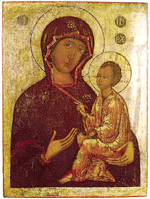
|
“The
Tikhvin Mother of God,” ca. 1660,
egg tempera, gold leaf on wood panel,
35" x 25".
|
According
to tradition, the original Tikhvin icon was
painted by the Evangelist Luke and sent by him
to Antioch. From Antioch, the icon was sent
to Jerusalem, and later, in the 5th century,
to Constantinople where a temple was built especially
for it in the Blachere District. Although the
icon disappeared from Constantinople several
times, the last time it left the ancient city
was in 1383.
The
icon first appeared in the Novgorod region of
Russia during the reign of Prince Dimitry Ivanovich
Donskoy. The first people to record its miraculous
appearance were fishermen on Lake Lodoga, who
reported seeing a bright light above them. The
icon then came to rest about 25 miles from the
lake at Smolnovo. The residents there built
a chapel, and many were cured of ailments.
The
icon is said to have mysteriously moved about
from place to place, and in each place, the
people erected chapels and soon temples. The
icon finally came to rest at Tikhvin on the
Tikhvin River in 1510. A wooden temple was built,
dedicated to the feast of the Dormition, and
the many who came to venerate the icon were
cured of their ailments. The icon is especially
revered for helping cure children’s illnesses
and protect families.
Several
times the wooden temple that housed the miraculous
image was leveled by fire, but the icon remained
unharmed. Through the efforts of Prince Basil
Ivanovich (1503-1533), a stone church was built
to replace the wooden temple, which had burned
down. During construction, a section of arches
crumbled, burying 20 workmen. Although all considered
them dead, after three days the 20 men were
found alive.
About
50 years later, a monastery was established
at the church. The Tikhvin Monastery was believed
saved from destruction by the intercession of
the Tikhvin Mother of God in 1613 when the Swedish
forces invaded the country and besieged the
cloister.
The
size of the icon pictured here suggests it was
most likely a church icon placed in the local
tier of the iconostasis. It is quite probable
that the church or chapel which once held this
icon was named “Tikhvin.” The style and color
conform in almost every way to the “old” style
of icon painting. It is a fine example of an
icon which displays a small, but all important
feature, revealing one of the first elements
of Western influence to be detected in traditional
icon painting of the period. In this icon, the
eyes of Mary display an anatomically correct
feature, which would have never been included
in an icon painted only a few decades earlier—tear
ducts.
*
* * * * * * * * * * * * * * * * * *
|
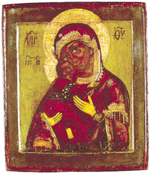
|
“The
Vladimir Mother of God,” ca. 1680,
egg tempera on wood panel, 12"
x 10".
|
This
is a classic “Tenderness” type icon, so called
because the heads of Mary and the Christ child
incline in a tender cheek-to-cheek embrace.
This is the most famous of the icons attributed
to St. Luke. It was brought to Kiev from Constantinople
in 1155, and then taken by the great Prince
Andrey Bogolyubsky during his sacking of Kiev.
In 1161, it was placed in the city of Vladimir,
from which the name is derived.
The
“Vladimir” is said to have saved Moscow from
Tamerlane in 1395 and from the Poles in 1612.
It is considered a great miracle worker, and
consequently, multitudes of copies exist. The
original icon has been repainted several times,
and after restoration, only the faces of the
Mother and Child remained original. The original
icon is displayed at the Tretyakov Museum in
Moscow.
A
bitter battle persists between the Russian Orthodox
Church and the government of Russia over this
and many other famous icons. The Church demands
the return of icons which were stripped from
the churches during the Communist period. The
government insists that they are national ethnographic
art treasures belonging to the people.
This
icon illustrates a more naturalistic rendering,
a major deviation from the flat old or Byzantine
style icons. Here, both the face of Mary and
Christ are rounded and somewhat more three-dimensional.
The double raised border, or “kovcheg,” was
common in the 17th century, then it gave way
to flat painting surfaces. The two large inscriptions
on either side of Mary’s head are the Greek
abbreviated title for Mary; i.e., “Meter Theotokos,”
or “Mother of God.” The small inscription to
the side of Christ’s head, “CXC,” is the Russian
abbreviation of Isus Khristos—Jesus Christ.
*
* * * * * * * * * * * * * * * * * *
|
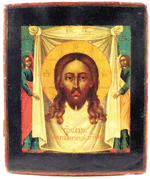
|
The
“Image Not Made By Hands,” ca. 1790,
egg tempera on wood panel, 12"
x 10".
|
An
interesting story explains the traditional origin
of this icon type. In New Testament times, King
Abgar of the Syrian city of Edessa fell ill
and sent his court artist Ananias to sketch
an image of Christ. So great were the stories
of Christ’s healing power that King Abgar believed
if only he could see an image of Jesus, he too
could be healed.
Ananias
was unable to get close enough to sketch Christ.
However, knowing this, Christ sought him out
in the crowd and pressed a cloth to his own
face, miraculously imprinting it with his image
and telling Ananias to take the cloth to Abgar.
Upon seeing the cloth, Abgar was healed, but
retained a slight touch of his former illness
until Thaddeus, a disciple of Christ, came and
baptized him.
Because
the image appeared miraculously and was not
painted, it is called “The Image Not Made by
Hands.” It is also sometimes referred to as
the “first icon.”
In
this example, like many, the cloth is held by
two angels. The short inscription at the top
is the Greek for “Jesus Christ.” The head of
Christ is surrounded by the distinctive cross-halo
inscribed with the Greek words “HO ON”, meaning
“Who Is,” found in Revelation 1:8 and given
in Exodus 3:14 as a title of God. The inscription
at the bottom of the cloth reads, “The Image
of Christ Not Made by Hands.”
This
image should not be confused with the Roman
Catholic story of “Veronica’s Veil,” which is
a later development of the Abgar legend. This
sample reveals a more life-like depiction of
Christ in the style which became popular after
the great schism. The painter was obviously
influenced by the works of Simon Ushakov, the
famous Moscow Armory School icon painter of
the late 17th and early 18th century.
James L. Jackson is president and CEO of Jackson's
International Auctioneers of Cedar Falls, Iowa. He can be contacted at
319-277-2256 or through the website at www.jacksonsauction.com. All photos,
courtesy James and Titiana Jackson and www.sacredartgallery.com
|
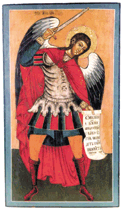
"Angel of the Lord," ca. 1800, silver leaf on wood, 49 x 24 in. Usually
positioned above church doors, this icon was viewed while exiting the angel
dressed as a soldier reminds one that God is always watching.

"Image Not Made By Hands," ca. 1790. After Christ pressed a cloth to his face,
this image was left on it. It was sent to a sick king, and it healed him.
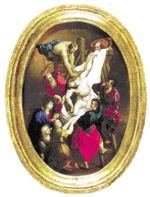
"Removal From The Cross," 18th c., 12.25 x 9 in. Joseph of Arimathaea and
Nicodemus take Christ down from the cross while Mary and other women look
on.
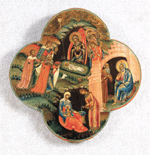
"The Nativity of Christ," ca. 1800,
19 x 19 in. The nativity
scenes
include Joseph (r.) listening to an old shepherd (the devil
in
disguise) who is tempting
him to doubt the virgin birth.
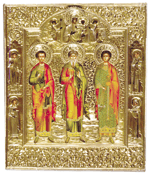
"Saints Samon, Guriy and Avi," ca. 1886. This type was produced in the Tsar's
icon workshop. Referred to as a "magnifying glass" icon because of the detail
each hair on their heads was individually painted.
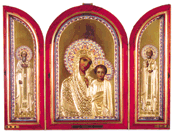
"The Kazan Mother of God with Saints," ca. 1899-1908, an oil on metal triptych
depicting St. Leo Katanskiy, the Kazan Mary and Jesus, and St. Nicholas. Only
affordable to the wealthy, finely crafted triptychs were often taken on trips
and referred to as "traveling" icons.
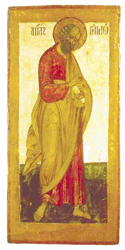
"The Apostle Simon," ca. 1660, egg tempera on wood panel,
44.25 x 21".
|